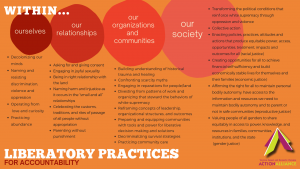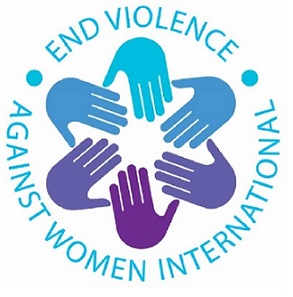Resources Library: Law Enforcement
Start a Search:
Levels of Violence in the United States
This document was provided at the workshop titled "Beyond Trauma: A Presentation of Dr. Stephanie Covington’s Trauma Theory and Beyond Trauma Women’s Groups" at the Virginia Department of Social Services Office of Family Violence Promising Practices conference on September 16, 2013.
Liberatory Practices for Accountability Across the Social Ecological Model

What does accountability look like without punishment, isolation, and shaming?
What are the shifts we can make in ourselves, our relationships, communities, and as a society to move from punishment to true accountability, which builds connection and encourages growth?
This infographic, created for the Action Alliance webinar series, “Reimagining Our Legacy: Transforming from Criminalization to Liberation”, seeks to offer a few ways in which we can practice methods of accountability that liberate us from punishment and harm and move us toward healing and connection.
Officers and Advocates: Oil and Water?

From End Violence Against Women International
One of our most popular articles addresses the collaboration between law enforcement and victim advocates, with the title Oil and Water? This article was first written years ago, but it remains just as timely today. We are therefore providing the information in a series of Training Bulletins.
In this first installment, we begin with a historical perspective and explore the role of victim advocates within the context of the criminal justice system. In the second bulletin, we describe why some professionals are reluctant to integrate victim advocacy in their work and identify strategies for overcoming that reluctance. Then in the final installment, we walk through an example of how advocates might address one particular challenge: When the law enforcement investigator feels like the facts "don't add up."
CLICK HERE FOR PART 1 OF THE SERIES.
Pet Abuse and the Link to Domestic Violence

Sheltering Animals for Abused Families (http://www.richmondspca.org/saaf)
SAAF (Sheltering Animals for Abused Families) Program is a partnership between the Richmond SPCA and the YWCA, with the purpose of providing a safe, temporary shelter to care for the pets of abused women and children.
Safe Havens Mapping Project – Virginia
The entities included in this listing either provide sheltering services for the companion animals of domestic violence victims, have a relationship with an entity that does, or provide referrals to such facilities.
https://awionline.org/safe-havens?distance[postal_code]=&distance[search_distance]=25&distance[search_units]=mile&state=Virginia
Virginia Consolidated Cruelty Statutes
https://www.animallaw.info/statute/va-cruelty-consolidated-cruelty-statutes
Domestic Violence and Animal Cruelty - ASPCA Resources Including What Law Enforcement Can Do About It
https://www.aspca.org/fight-cruelty/report-animal-cruelty/domestic-violence-and-animal-cruelty
National Link Coalition – Working Together to Stop Violence Against People and Animals
Rich source of information and guidance.
http://nationallinkcoalition.org/
RedRover Domestic Violence Safe Escape Grants
RedRover offers financial assistance for victims of domestic violence and their pets through our Safe Escape grant program. The goal of the program is to help families with pets safely escape domestic violence together. Grants may be provided for temporary boarding and veterinary care.
http://www.redrover.org/domestic-violence-safe-escape-grants
American Humane Association: Facts About Animal Abuse & Domestic Violence
http://www.americanhumane.org/interaction/support-the-bond/fact-sheets/animal-abuse-domestic-violence.html
Power and Control Wheel: Abuse in Later Life
The Power and Control Wheel is a tool that helps explain the different ways an abusive partner can use power and control to manipulate a relationship. During 2005, NCALL staff asked facilitators of older abused women’s support groups to have participants review the Duluth Domestic Abuse Intervention Project’s Power and Control Wheel. Over 50 survivors from eight states responded. NCALL created this Abuse in Later Life Wheel from their input.
In addition to the tactics on the wheel, many offenders justify or minimize the abuse and deny that they are abusive. Perpetrators of abuse in later life may make comments like “she’s just too difficult to care for” or “he abused me as a child” to blame the victim, or try to minimize the abuse by stating the victim bruises easily or injuries are the incidental result of providing care.

